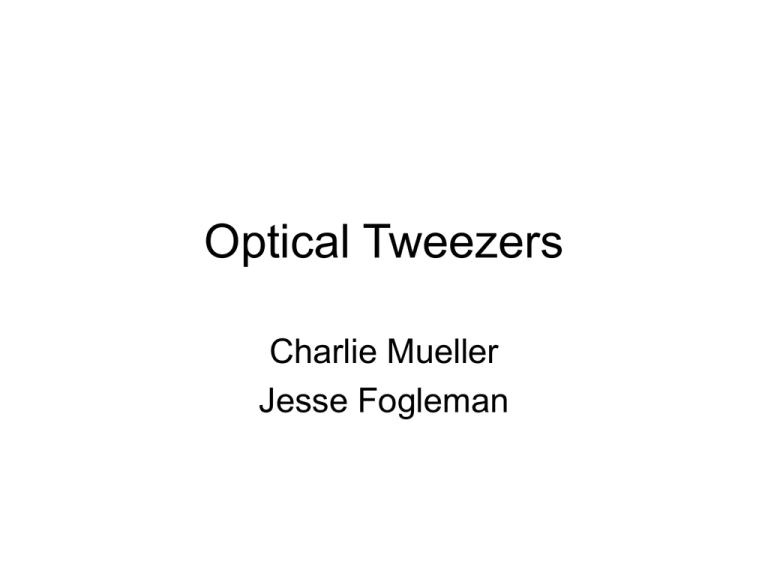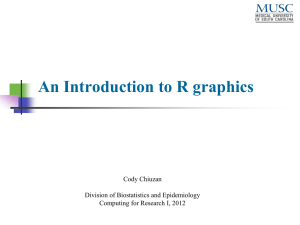Optical Tweezers
advertisement

Optical Tweezers Charlie Mueller Jesse Fogleman Qualitative Description In a nu tshell , optica l tweezers all ow us t he abili ty to re m ot ely c o ntrol m atte r w ith the use of lasers. T he idea of m ov ing m att er w ith li ght is not n ew. Jo hann es K ep ler obser ved t hat the t ail s o f com ets wer e a lwa ys pointing awa y from the S un. K ep ler k new t hat t h e Su n had t o b e exer ting som e kind of rad iant pressure b ut c ould n ot verify t his. F our ce ntur ies later, the idea of us ing li ght to m ove m att er h ad bec om e a rea li ty and q ua n tu m m ec hanics helps us unders tand how. L ight is able to m ove m att er because p hot ons carr y m om entum . A photo n w ith any wa velength carr ies a m om entum p h ( h is P lanck Õs c onstan t). T his m ea ns t hat w hen a n a to m emi ts or absorbs a photo n itÕs m om entum c hanges, in acc orda nce w ith New to nÕs laws. A lon g t he sa m e li nes, w hen a par ticle chan ges t he direc tion of a bea m of li ght as a resu lt of re fl ec tion or refrac tion, it exper iences a force. T he firs t o ptica l traps were used i n 197 0 a t the A T & T Be ll labs in the U nited S tates. T he ear ly traps Òlevitated Ó the par ticle by ba lancing t he fo rce of gra vity or m ade use of tw o c ounte r-pr opaga tin g bea m s to trap the par ticles . In 198 6, it was disc overed t hat grad ient forces alone w ould su ffi ce in t rapp ing a particle. N ow , only a tightly focused single bea m was requ ired to hold and m ove a par ticle in three dim ensions. Qualitative Description 2 H ow do you focus a single laser bea m ? Pass i t throug h a mi cr osc ope Õs objec tive lens! T he mi cr osc ope objec tive m us t have a high nu m er ica l aper ture (a m easure of the angle at w hich the bea m appr oac hes t he focal point) . T his tigh tly focuses the b ea m s o the g rad ient to t rap the par ticle is eff ectively s tron g enoug h. T he sa m e lens m ay then be used to im age the trapped par ticle, usua lly routed to a m onito r. A laser w ith only a milli wa tt of power is neces sar y to tra p a single, tra nspare n t par ticle. Op tica l tweezers exploit a refrac tive inde x mi sm atch. T ra nspare nt par ticles have a higher re frac tive inde x than t heir surr oundings and are att rac ted to area of m ax im um inten sity w here the bea m is m ost tightly focused , k now n as t he bea m wa ist. B y m oving t h e focus of the laser bea m ar ound a li ttle, dielec tric and biologica l par ticles ca n be gra bb ed a nd m oved in three dim ens ions. H ow b ig of a pa rt icle ca n the b ea m handle? A lth ough the o ptica l force of the t weezers is only on the order of p iconew to ns, this is su itable enoug h to m ov e par ticles from tens o f nan om eters a ll the wa y u p to tens of mi crons, bec ause at the mi cr o-level the optica l forces are usua lly supre m e. DN A , itÕs prote ins and enzym es are m ost com m only m anipu lated w ith optica l tweezers. Ray Tracing Analysis of Force Trap 1 sin( i ) 2 sin( r ) 2 sin( i 2 ) 1 sin( r 2 ) 180 ( r i 2 ) 1 h Incoming light p ray 1 0 0 0 n m 2 r 2 i r i 2 2 i 2 1 r i2 i r i2 Dielectric particle being trapped Exiting light ray p h ' Scattering force vector Force vector exerted by light on dielectric particle as a result of momentum conservation Electric Dipole Approximation • The force on charge particle in an electric field is given by the Lorentz Force Equation: d 1 q2( E 1 1E 2 2p Ed E EFq(E B (FE E ) ( B )B )] p1(E E)E FF(Eq[F F)E ((d [(p )E ( )E EEE BB)B))]E 2v 1 1 ) tt tt 22 2 t 1 B B E 2 [ E EE( ) B )] 2 t t t 1 2 [ E ( E B )] 2 t QuickTime™ and a decompressor are needed to see this picture. Sources Used: • • • A. Ashkin, J.M. Dziedzic, J.E. Bjorkholm and S. Chu. 1986. "Observation of a Single-Beam Gradient Force Optical Trap for Dielectric Particles." Opt. Lett. 11 (5) 288-290. Block S. M. 1992. "Making light work with optical tweezers." Nature 360(6403):493-5. Dholakia, Kishan, Gabriel Spaulding, and Michael Macdonald. "Optical Tweezers: the next Generation." Physics World Oct. 2002. Physicsweb.org. Oct. 2002. Web. 13 Nov. 2010. http://physicsworldarchive.iop.org/index.cfm?action=summary&doc=15%2F1 0%2Fphwv15i10a37%40pwa-xml&qt • Pressurized Viruses, Gelbart, et al.Science 27 March 2009: 16821683.DOI:10.1126/science.1170645 http://www.absoluteastronomy.com/topics/Optical_tweezers








